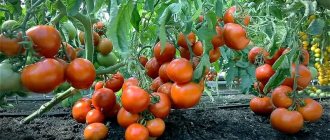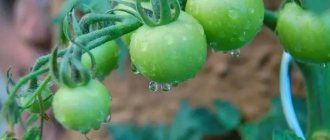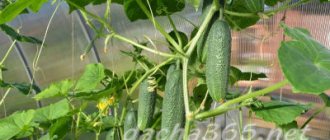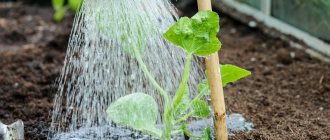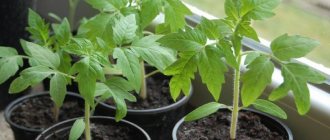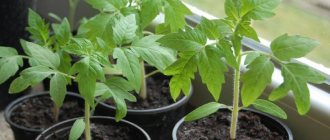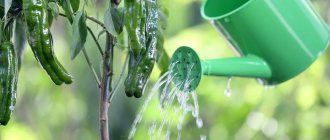A greenhouse is an excellent help for summer residents and farmers, because it allows you to speed up the ripening of crops, protect crops from diseases, pests and the vagaries of the weather. In order not to upset the humidity balance, you should properly water the plants in a polycarbonate greenhouse. We'll tell you how to properly organize irrigation for the main inhabitants of a greenhouse - peppers, tomatoes and cucumbers.
How often to water tomatoes in a greenhouse
The frequency of watering tomatoes grown in greenhouse conditions plays an important role in their development and fruiting. Such a crop can be equally damaged by both overwatering and lack of moisture; in this case, the bushes begin to ache, which has an extremely negative effect on the quality and quantity of fruits.
You can understand that the selected irrigation mode is incorrect by the following signs:
- all leaf plates on the bush lose turgor and begin to fly off due to insufficient or too poor watering;
- curled foliage is a sign that watering is too frequent or excessive.
On average, tomatoes growing in a greenhouse are watered 1-2 times a week. In this case, the frequency of watering is affected not only by temperature, but also by air humidity.
Watering cucumbers with fertilizer
Cucumbers need not only proper care, but also careful selection of the soil in which they will grow. Experienced gardeners do not recommend growing them where tomatoes and other nightshade crops once sat. In addition, plants need periodic fertilization. There are a large number of folk recipes using the means available to every summer resident for the preparation of nutrient substrates.
Healthy! To prevent the appearance of root rot, which is caused by fungi that live in the soil and reproduce in high humidity, use the following remedy: 1 liter of milk or kefir, 1 tbsp. crushed laundry soap (liquid soap can be used), 30 drops of iodine per 10 liters of water. Cucumbers are sprayed with this mixture no more than once every 10 days.
Yeast
A yeast cocktail can be used for healthy plantings to form new root shoots. Their increase will help the plant absorb more nutrients from the soil, strengthen the plant’s immunity and increase its resistance to pests. Preparing fertilizing is very simple
- Fresh yeast (10g) and granulated sugar (2 tbsp) are dissolved in 10 liters of warm water.
- The solution is left for 2 hours in a warm place for fermentation.
- The resulting substrate is supplemented with another 50 liters of water.
This feeding is carried out no earlier than 14 days after transplanting the cucumbers into a greenhouse or open ground.
Zelenka
To prevent root rot, plantings can be watered with a solution of brilliant green at the rate of 1 drop per 1 liter of water. The substrate is poured into the ground near the roots.
Soda
Soda solution is an excellent preventive measure in the fight against yellowing of the leaf plate.
1 tbsp baking soda dissolves in 10 liters of water. This cocktail is used to water plants.
To spray vegetative parts, which will help destroy powdery mildew, dissolve 1 teaspoon of soda in 1 liter of water.
Potassium permangantsovka
You can water cucumbers with potassium permanganate to combat powdery mildew. Plants, as a rule, are sprayed three times with this solution: 3 g of potassium permanganate per 10 liters of water. You can also cultivate the ground around the bush.
Urea
When cucumbers begin active growth, they can be fed with a urea solution (30 g per 10 l). This fertilizer is applied to the soil approximately 14 days after planting. The treatment can be repeated at the stage of fruit formation.
Mullein
Watering cucumbers with mullein can be done several times throughout the entire growing season. About once every 12 days. By the way, this feeding is especially useful for cucumbers with thin stems. The first time you can water only two weeks after germination.
You can’t just mix mullein with water! Fertilizer must be prepared in advance. Here's the principle: 1 part mullein to 2 parts water, the mixture should be infused for a week. But the infusion cannot be used in this form either. After a week, when the mixture has infused, take about 500 ml per bucket of water. And we water the cucumbers with this fertilizer. Only this solution is safe for planting!
Ammonia
Ammonia is a popular nitrogen-containing agent. It is often used to prepare the appropriate fertilizer. To do this, 3 tablespoons of ammonia are poured into 10 liters of water.
The first fertilizing is carried out two weeks after planting the plants in the ground, then it is recommended to apply this fertilizer to the soil weekly.
Milk
From milk and iodine you can prepare a highly effective means of combating powdery mildew. 10 drops of iodine are added to 10 liters of water, into which one liter of low-fat milk is poured. The resulting mixture is watered onto the ground near the roots of the bush.
Boric acid
Fertilizers with boric acid activate the formation of ovaries and stimulate the growth of plantings. To begin with, 1 teaspoon of acid is dissolved in a glass of water, the temperature of which should be at least 50 degrees. As soon as the substance is completely dissolved, about 2 more liters of water are added to it.
succinic acid
Succinic acid is used at the seed preparation stage. It helps increase their endurance and stimulates the growth of future seedlings. Prepared seeds are soaked for 24 hours in a solution prepared at the rate of 1 g of substance per 10 liters of water.
Nettle
You can make fertilizer for cucumbers from nettles. To do this, the weed is crushed and filled with water that has been pre-settled for 24 hours. Leave it in this form for two weeks, the smell will be unpleasant, so be sure to close the container with a lid or wrap it with film.
This fertilizer must be diluted with water before watering: for application under the roots - in a ratio of 1:2; for the above-ground part – 1:5.
Yeast, ash, green manure
Boric acid
Urea and others
Yeast
Iodine
Ammonia
Mullein infusion
Potassium permanganate solution
herbal infusion
Serum
Whey is an extremely nutritious fertilizer for cucumber plantings. To prepare it you will need:
- 10 liters of water at room temperature or slightly warmer.
- 1 liter of whey.
- 10 drops of iodine.
All ingredients are mixed together until completely dissolved. The resulting nutritious fertilizer is sprayed on the vegetative parts of plants. Before starting work, remove all damaged leaves from the bush. The repeated procedure is carried out no earlier than two weeks later.
Hydrogen peroxide
Hydrogen peroxide is ideal for preparing a solution, the action of which is aimed at preventing all kinds of diseases. To obtain it, dissolve 2 tablespoons of hydrogen peroxide (3%) in 1 liter of water. With this substrate, you need to thoroughly wipe all the leaves on both sides, paying special attention to their underside - the favorite place for aphids and mites to be located.
Onion peel
Onion broth is perfect for both spraying and watering. It helps protect plantings from pests. To prepare it, 40 g of husk is poured into 10 liters of warm water, the solution is infused for about 4-5 days, after which it must be filtered and the bushes treated.
Features of watering tomatoes in a greenhouse
Experienced gardeners know that the frequency and abundance of watering tomatoes grown in a greenhouse depends on what stage of development the bushes are at.
After disembarkation
After the seedlings are transplanted into the bed in the greenhouse, they should be well watered with plenty of water. Transplanted seedlings are initially in a depressed state, and their root system is still very weak, so special attention should be paid to soil moisture during this period.
However, there is no consensus on this matter:
- Some experts advise watering the planted seedlings daily, using a small amount of water, arguing that the weak root system is not able to absorb too much liquid, and since it has not yet grown, it is not able to extract moisture from deeper layers soil.
- Other experts are confident that after the bushes are watered abundantly after planting (4–5 liters of water per bush), they should be left alone for a week. During this time, they will have time to take root, and their root system will become stronger.
During active growth and flowering
When the seedlings take root and begin to grow actively, the frequency of watering should be such that the soil surface between them has time to dry to a depth of 30–50 mm. As a rule, at this time the soil is moistened once every 5 days.
If you water tomatoes more often, then only their superficial root system will develop well, which is not able to provide the plant with all the necessary nutrients. The same watering regime is provided to this vegetable crop during flowering.
During fruiting in July-August
During the period of fruit set, the amount of watering is increased. The fact is that at this time the bushes spend a lot of moisture on the growth of fruits, but if there is too much liquid in the soil, this can cause them to crack.
Make sure that the soil is always slightly moist, but do not allow water to stagnate in the root system. On average, at this time watering is carried out twice every 7 days.
However, if the surface of the earth near the bushes is very wet, then the number of waterings can be reduced to once every 5 days.
When the fruits grow and begin to ripen, the watering regime should be changed again. If you water the bushes too much and often at this time, then the ripening tomatoes will not only crack, but also begin to rot. As a rule, at this time the soil is moistened once every 1–1.5 weeks.
Read more in the article: How to water tomatoes in open ground
Watering carrots (beets, radishes, celery root, daikon)
The main rule when watering carrots and other root vegetables is regularity and abundance of watering.
At the beginning of growth, carrots are watered once every two weeks. In the second half of the season, during the formation of root crops, the frequency of watering can be increased to once a week, and in dry summers - up to 2-3 times. You should not allow the soil to dry out and then rush to water - the carrots may crack or form a gnarled root.
The depth of watering carrots and other root vegetables is 30-35 centimeters. If the soil does not get wet to such a depth, the carrots begin to grow lateral roots, they become shorter, and may bifurcate.
One to two weeks before harvesting carrots, stop watering altogether. Only the night before harvesting can carrots be watered - this way they will retain their juiciness longer.
With low soil moisture, radishes become coarse and quickly go to seed, so they are watered every other day.
Root celery requires constantly moist soil, otherwise it will not form roots. It is watered once every 2-3 days, on hot days - every day.
How to organize watering yourself
There are several ways to water tomatoes grown in a polycarbonate greenhouse. Each of them has its own advantages and disadvantages. The most common of them will be discussed below.
Manual watering
If the greenhouse is small, then it is recommended to use the manual method for watering tomatoes. To do this, you will need either a watering hose or a watering can, and the water must be poured at the root.
The disadvantage of using a watering hose is that in this case the water comes either from a water supply or from a well, and it is very cold, so the likelihood of hypothermia of the root system increases. This method is also bad because it is impossible to control the amount of water poured under the bush.
Experienced gardeners recommend using a watering can in this case. In this case, it is better to take water that has settled and heated in the sun. To do this, you can install a barrel near the structure, into which water is poured in advance so that it has time to heat up.
Drip irrigation
Drip irrigation is advantageous to use in large greenhouses, since manual watering in this case is too complicated and time-consuming.
This method has many advantages:
- the liquid goes directly to the root system, so it does not evaporate on the soil surface, which means that watering will not increase air humidity;
- water will not get on the surface of foliage, shoots or flowers;
- You can water tomatoes at any time of the day;
- When watering, the soil does not become salty or washed away.
To provide drip irrigation to plants, you will have to install a special system, which consists of many special tubes connected to each other, they are connected directly to the roots of the plants, and it is through them that water flows to them.
The easiest way is to purchase a ready-made drip irrigation system at a specialized store, but if you wish, you can assemble it yourself.
How to organize drip irrigation in a greenhouse - video
Pit irrigation
Pit watering of tomatoes is a rather unusual method that some gardeners are just beginning to use.
- In this case, a hole is dug in the bed 0.3 meters deep and 0.5–0.6 meters in diameter.
- Four tomato bushes are planted along the edges of this pit, and the distance between them should be from 0.5 to 0.6 meters.
- After planting, the hole must be filled with mowed grass so that it rises slightly above the surface of the bed.
- When watering, pour water only into this grass; 20 liters of water are poured into one hole at a time.
This method is good because the tomato is watered deeply, due to which the root system of the bushes becomes strong and well developed. And over time, the mown grass begins to rot and warms the roots of the plant, which also has a positive effect on their development and growth.
This method also allows you to reduce the number of waterings; the bushes can be charged with moisture for about 7–10 days (sometimes longer).
Watering with plastic bottles
The method of watering tomatoes using plastic bottles is very popular among gardeners. The fact is that the consumables in this case cost practically nothing; you only need a few plastic bottles, nails and old tights.
It is very easy to build a structure from bottles, and it can serve you for many years. There are several options for such designs:
- Funnel. Take a bottle and make several holes in its cork with a nail. If the soil in the garden bed is light, then make just a couple of holes in it with a diameter of about 0.2 cm, and if the soil is heavy, then you will need 4 larger holes. The cork should be covered with unnecessary tights or other synthetic material (natural material may rot). This is necessary so that the soil does not clog the holes. Then cut off the bottom of the bottle, but not completely, make something like a lid. Place the resulting “funnels” in the garden bed between two planting holes at a depth of 15 centimeters and at an angle of 45 degrees, then fill the container with water.
- Upside down into the ground. In this case, holes are made on the sides of the plastic bottle, after which tights are put on it. Then the container is dug in between two planting holes strictly vertically so that only the neck rises above the surface. You will need to pour water into it from time to time. You cannot close it with a cork, as in this case the liquid will not be able to leave the bottle and be absorbed into the soil.
Watering planted seedlings
A few days before planting the seedlings in a permanent place, they stop watering them. But 1-2 hours before replanting, the soil should be properly moistened to avoid injury to the roots of the plant. The planted seedlings are immediately watered abundantly, and the soil is mulched so that the moisture evaporates more slowly.
- Planting seedlings - how to avoid mistakes?
How to properly transplant vegetable seedlings into a greenhouse and open ground without harming your green pets.
The first watering of seedlings after planting in the ground is carried out only after 10-15 days, then the seedlings are watered every 3-7 days (water consumption per hole is 3-5 l), each time loosening the soil after watering to 8-10 cm in depth.
There are different methods of watering seedlings, the most popular are sprinkling (water from a watering can with a mesh is poured onto the leaves of the plant) and watering at the root (water is poured directly onto the soil, so that drops do not fall on the leaves of the seedling). Tomatoes, eggplants and peppers are watered exclusively at the root, since moisture on the leaves can cause late blight and other diseases.
When to water
The time for watering tomatoes grown in greenhouse conditions directly depends on weather conditions and the design features of the greenhouse. As a rule, if the weather is dry and warm, then you can water your tomatoes at any time except at night. But in this case, during the daytime, you need to pour water very carefully at the root so that it does not get on the surface of the foliage, since the sun's rays in this case can leave burns on the leaf plates.
Experienced gardeners recommend starting watering in the afternoon, since by this hour the water in the barrel has time to warm up well, because it cools down overnight.
Please note that you cannot water the bushes in the late evening or at night, because the greenhouse is tightly closed at night and therefore the air humidity rises very strongly, which is detrimental to tomatoes.
If you decide to water the tomatoes in the evening, then ventilate the greenhouse well to remove excess moisture from it.
If the weather is cool and damp, then watering is carried out before lunch, in which case the structure will have time to be well ventilated until the evening.
Required microclimatic indicators
How to water correctly, the frequency and volume of water must be determined based on the microclimatic conditions of the greenhouses. The air in summer has a humidity of approximately 60 to 80%. Only on very hot days can the humidity be lower and reach 40%. During summer showers alternating with hot weather, air humidity can approach 90%.
If watering of tomatoes in a polycarbonate greenhouse is not organized correctly, then the humidity can significantly exceed the permissible value, which has a detrimental effect on the tomatoes. The peculiarity of tomatoes is that their above-ground part prefers dry air, and the roots require a sufficient amount of water to ensure the growth of stems. Therefore, optimal conditions should be created in the greenhouse by choosing the correct irrigation regime.
An excess amount of water, which forms stagnation at the level of the root system of tomatoes, causes rotting of the roots. But if there is not enough water in the soil, the foliage becomes dehydrated, causing the plants to overheat, which can lead to the death of the entire bush.
Note! If tomato leaves curl relative to the central vein, forming a kind of “boat,” then this is a clear sign of insufficient soil moisture. .
The calculation of the number of tomato waterings in a greenhouse is carried out in such a way that they provide ninety percent soil moisture and 50% air humidity. This ratio allows the bushes to develop normally, and at the same time, protects the plant from infection by fungal bacteria. To maintain an optimal microclimate in the greenhouse, tomatoes are watered every 3-7 days, based on the level of temperature and air humidity.
When irrigating tomatoes, it should be taken into account that each bush needs 4-5 liters of water, which should only flow into the soil to the root system of the plant, and so that drops do not fall on the foliage. On a sunny day, a drop of water acts as a lens, projecting the sun's ray and increasing its power many times over, causing a leaf burn. Therefore, it is recommended to carry out irrigation early in the morning or in the evening, so that the moisture has time to be absorbed into the soil without creating a greenhouse effect during evaporation.
Remember! Watering tomatoes with cool water stresses the plant. The optimal water temperature for irrigation should be no less than +23–+24 degrees.
See also
Characteristics and description of the Velmozha tomato variety and its yieldRead
Advice from experienced gardeners
If this is your first time deciding to grow tomatoes in a greenhouse, then you will certainly find the advice of experienced gardeners useful:
- If you heat water for irrigation in a barrel and install it inside the greenhouse, then be sure to cover it tightly with a lid or film. The same applies to any other containers filled with water. If this is not done, then the liquid will begin to evaporate, and this will significantly increase the level of air humidity.
- If the soil in the garden bed does not absorb water well, it is recommended to carefully dig it with a pitchfork.
- It is extremely undesirable to regularly loosen the surface of the soil around tomatoes grown in greenhouse conditions. Instead, immediately after planting, cover the surface of the bed with a layer of mulch (hay or straw).
- In warm weather, the optimal temperature of water used for irrigation should be from 18 to 20 degrees, and in cold weather - from 22 to 24 degrees. If the water is cold, then the tomatoes will experience stress after watering, which will negatively affect their growth and fruiting.
- Immediately after watering, be sure to ventilate the greenhouse well (if you do not have a ventilation system installed). Otherwise, air humidity will rise sharply, which is extremely undesirable.
Tips from Mister Summer Resident
Proper watering is the key to obtaining an excellent harvest, which will delight you not only with its large quantity, but also with its excellent quality. Following the advice of our website https://mrdachnik.com on watering cucumbers in a greenhouse will help you avoid many mistakes. Here are the main ones:
- Drying out the soil most often causes bitterness in cucumbers. Water for irrigation should not be cold. Watering the bed should be periodically combined with fertilizing and loosening it.
- When there is excess moisture in the soil, a white coating forms on its surface. It indicates that watering is carried out too often and extremely abundantly, it needs to be reduced.
- A chalk solution poured over the walls of a glass greenhouse will help darken them a little. This measure allows you to obtain diffused lighting inside the structure, which cucumbers perceive better than direct sunlight.
- It is best to water in circular grooves dug around the root of the planting at some distance from the base of the stem. If you pour water under the root, the soil will be washed away and the risk of rot and mold will increase.
- A drip irrigation system can be constructed from ordinary plastic bottles with the bottom cut off. A bottle with holes pre-drilled in it is dug into the ground, neck down, near each bush. Then it is filled with water, which through the holes will gradually moisten the soil and nourish the roots.
- It is strictly forbidden to sprinkle those plantings that have fungal diseases. You can water them only at the root.
- Iodine and urea can be added to the water that will be used to irrigate cucumbers in the greenhouse. They will provide the plantings with additional protection against infections.
Temperature and quality of water for irrigation
Water for watering cucumbers should have a temperature of 20-25 degrees. It is ideal if the water temperature matches the soil temperature or is slightly warmer. If you preheat the water yourself, under no circumstances bring it to a boil, otherwise it will become dead and lose its beneficial properties.
It is best to pre-settle the water in barrels directly in the greenhouse or in the air under the sun, so it will acquire the desired temperature on its own. In order for moisture for irrigation to be fully absorbed by the roots, it should not contain an excess of harmful salts and fluorine. Hardness indicators can be softened by adding wood ash at the rate of 2 tbsp. spoons per 10 liters of water.
On a note! If you water cucumbers with too cold water, the plant’s immunity will decrease, they will be more susceptible to diseases and attacks by harmful insects, and development and growth will slow down.
What types of irrigation exist
Experts distinguish several types of irrigation depending on the purpose of its use:
- planting and post-planting , which improves the survival rate of crops after sowing seeds and planting seedlings;
- the main one is to replenish moisture in the soil during the growing season;
- fertilizing , which allows you to apply dissolved fertilizers;
- refreshing - used at high air temperatures;
- anti-frost – to reduce the risk of plants freezing.
It is advisable to use different types of irrigation in combination. Then the plants will receive everything they need for full development.
Reduce leaf watering of plants
In order not to harm the foliage of plants, it must be moistened before the onset of heat, that is, early in the morning, preferably no later than sunrise. But waking up at such a time is often quite difficult, and therefore it is better to replace watering on the leaves with drip irrigation, and in a greenhouse with air humidification, which we have already mentioned.
In the evening, despite the decline in heat, it is also not recommended to water crops on the leaves. This is due to the difference in day and night temperatures. Remaining liquid on the leaves, combined with coolness, can provoke the development of various, mainly fungal, diseases.
- Anthracnose: photo and description of the disease, how and how to treat plants
Find out everything about this dangerous disease and how to combat it.
- Fusarium: signs and methods of treating a dangerous disease
Your plants suddenly began to turn yellow and wither, although there were no prerequisites for this? Most likely, the reason is the dangerous influence of one of the “fusarium” fungi. What to do?
Don't water your plants during the day
This applies to both soil crops and domestic plants. It has long been known that during hot weather, water quickly evaporates without having time to reach the roots. The opinions of summer residents regarding the time of day at which it is best to water crops vary. Both morning and evening watering have their positive sides, and in hot weather plants need water constantly. Some experienced summer residents recommend alternating morning and evening watering and thereby help crops normalize the processes that occur with them at different times of the day.
- How to properly water plants in the garden - tips for increasing the yield
Don’t know how, when and how much to water your garden in order to increase the yield? We'll tell you.
What water to water the garden
The temperature and quality of irrigation water is an important factor for plants.
Why can't you water with cold water? To prevent plants from getting sick after experiencing temperature stress (the same goes for too hot water). In addition, too cold or too warm water has a bad effect on the absorption capacity of the root system and the vital activity of soil microorganisms.
Therefore, the optimal water temperature for irrigation will be neutral in the range of 15-25°C. This can be achieved by filling a large container with water from a water supply or an artesian well in the evening, letting it settle overnight (or, depending on the outside temperature, warm up during the day) and reach a temperature that is comfortable for the plant.
The optimal difference between water and air temperatures is 15-20°C. If it is exceeded, the fruits may crack and lose their presentation.
Even if it's hot outside and you think your plants will like cold water from a hose, it's best to take your time and let it warm up. Only cabbage, garlic and onions, which are cold-resistant crops, can be watered with cold water. But even in this case, we recommend not pouring water under the root, but spraying it using a diffuser.
Sedimentation of water (especially tap water, river water) will also help to precipitate or evaporate possible harmful impurities, such as chlorine, in the first case, or an abundance of suspended particles, in the second. Ordinary water for irrigation can be alternated twice with healing infusions. For example, 3 tbsp. ash per 3 liters of water or the peel of two large onions, infused for a couple of days in 3 liters of water.
You can also use rainwater for irrigation, but only if there are no industrial facilities near your site. Otherwise the water will be contaminated.
